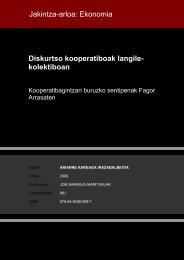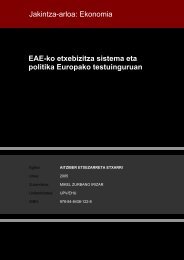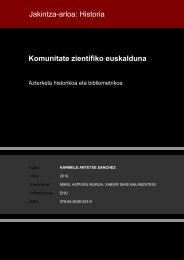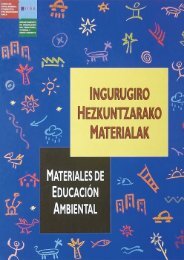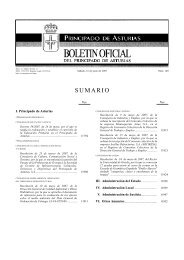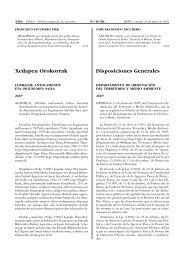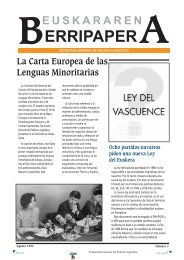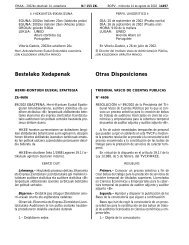Sinterizazio-atmosferaren eragina M graduko (ASP 30 ... - Euskara
Sinterizazio-atmosferaren eragina M graduko (ASP 30 ... - Euskara
Sinterizazio-atmosferaren eragina M graduko (ASP 30 ... - Euskara
You also want an ePaper? Increase the reach of your titles
YUMPU automatically turns print PDFs into web optimized ePapers that Google loves.
JOURNAL OF MATERIALS SCIENCE 27 (1992) 2026-2034<br />
Metallographic changes in the sintering<br />
of grade T high speed steels in an industrial<br />
atmosphere and vacuum<br />
R . H . PALMA, I . URRUTIBEASKOA, V . MARTINEZ, J . J . URCOLA<br />
Escuela Superior de Ingenieros Industriales de San Sebastián and the Centro de Estudios<br />
e Investigaciones Técnicas de Guipúzcoa, Donostia-San Sebastián, Spain<br />
The metallographic changes taking place in three T grade steels, T42, T15 and T1 in the range of<br />
optimum sintering temperature to oversintering in vacuum and in an industrial atmosphere - base<br />
nitrogen- have been investigated using SEM and EDS techniques . M 6 C and MC primary<br />
carbides have been observed for vacuum sintering and MX carbonitrides instead of MC carbides<br />
were found in the specimens sintered in the atmosphere . Small amounts of an eutectic carbide rich<br />
in Cr and Fe have been observed at the optimum sintering temperature . By oversintering in<br />
vacuum different type of eutectic carbides can be observed : MC, needle shape, M 6 C, but only<br />
M 6 C type eutectic carbide have been observed by oversintering the samples in the industrial<br />
atmosphere .<br />
1 . Introduction<br />
Work carried out in the last twenty years on the<br />
sintering of high speed steels has allowed the development<br />
of appropriate routes for the fabrication of high<br />
speed steels, which are now well established [1-7] .<br />
Although it is well known that direct sintering takes<br />
place by a supersolidus sintering mechanism [8-10],<br />
the details of the different phases and carbides taking<br />
place in such process are not totally clarified . Several<br />
carbides (M 6 C, M 2 C, MC, M 23C6 and M 3 C) found at<br />
room temperature after sintering are supposed to take<br />
part in the sintering process. Recently two steels T42<br />
[3, 11, 12] and M2 [13] sintered in vacuum have been<br />
studied in depth . In this work, which form part of an<br />
extended programme of the study of the influence of<br />
the atmosphere of sintering on the microstructure and<br />
the mechanical properties of several direct sintered<br />
high speed steels, the metallographic changes taking<br />
place during the sintering T grade steels in vacuum<br />
and in an industrial atmosphere, base nitrogen are<br />
analysed .<br />
2. Experimental procedure<br />
Annealed water atomized powders, with and without<br />
the addition of 0 .2% of elemental carbon in the form<br />
of graphite, were cold compacted uniaxially at a pressure<br />
of 500 MPa . This resulted in green densities of<br />
67-70% theoretical density . The compacts were sintered<br />
either in a flowing industrial atmosphere composed<br />
of 90% N 2-9% H 2-1% CH 4 or under vacuum<br />
better than 5 x 10 -3 Pa . The samples were heated<br />
to the sintering temperature at a mean rate of<br />
50 K min - ' and soaked for 45 min . Specimens were<br />
then cooled at a rate of 250 K min - ' . The sintered<br />
samples were sectioned and prepared according to the<br />
202 6<br />
standard metallographic techniques . Specimens in the<br />
as polished (with a 1 µm diamond) condition were<br />
observed in a 501B Philips scanning electron microscope<br />
fitted with an EDAX 9100 energy dispersive<br />
X-ray system, used to analyse the different carbides .<br />
3. Results<br />
3 .1 . T42 steel<br />
Fig . 1 shows the typical SEM micrographs at the<br />
optimum sintering temperature for T42 + 0 .2%C<br />
steel sintered in the gas atmosphere and in vacuum .<br />
The composition in weight percentage of the metallic<br />
elements of the different constituents marked in the<br />
micrographs are also included . The big round and<br />
grey MC carbides, rich in V, observed in the vacuum<br />
sintered specimens, are substituted by the small black<br />
and square MX carbonitrides, even richer in V than<br />
the MC carbides . In both micrographs the bright M 6C<br />
carbides, rich in W, present similar rectangular forms<br />
with nearly the same chemical composition . It is also<br />
observed that the Co is only present and in small<br />
amounts in the M 6 C carbides . With increasing the<br />
sintering temperature there is a tendency to the formation<br />
of eutectic carbides, like those present in Fig . 2, in<br />
which also the composition in weight % of metallic<br />
elements of the different eutectic carbides is included .<br />
The following eutectic carbide types are observed :<br />
(i) eutectic carbide, present at small amounts in all<br />
the samples at the optimum sintering temperature<br />
(type I) ;<br />
(ii) eutectic carbide type MC, present only in vacuum<br />
sintered specimens (10'C oversintering), with<br />
composition and contrast close to MC primary<br />
carbides ;<br />
0022-2461 C 1992 Chapm an & Hall



